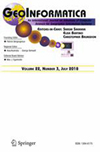投稿信息
投稿信息
审稿周期
投稿命中率
审稿费用
暂无数据
版面费用
暂无数据
中国人发表比例
2023年中国人文章占该期刊总数量暂无数据 (2022年为100.00%)
自引率
3.5 %
年文章数
426
作者需知
暂无数据
NCBI查询
偏重的研究方向
暂无数据
期刊简介
稿件收录要求
稿件收录要求
GeoInformatica is located at the confluence of two rapidly advancing domains: Computer Science and Geographic Information Science; nowadays Earth studies use more and more sophisticated computing theory and tools and computer processing of Earth observations through Geographic Information Systems (GIS) attracts a great deal of attention from governmental industrial and research worlds. This journal aims to promote the most innovative results coming from the research in the field of computer science applied to geographic information systems. Thus GeoInformatica provides an effective forum for disseminating original and fundamental research and experience in the rapidly advancing area of the use of computer science for spatial studies. Many topics in the field of computer science involve a very specific approach in the domain of geographic information systems; therefore the topics that are addressed include but are not limited to: Spatial Modeling : spatial data models integrating the geometric and semantic aspects of geographic information requirements analysis for GIS applications GIS performance modeling and evaluation qualitative aspects of geographic information impact of spatial information handling on computing models. Spatial Databases : spatio-temporal data structures spatial data storage and indexing techniques query processing and optimization spatial database knowledge discovery GIS metadata multidatabase GIS. Human-Computer Interfaces for GIS : graphic user interfaces for GIS graphic browser interfaces for navigating spatial databases multimedia applied to GIS virtual reality for representing spatial data. Digital Cartography at the Core of GIS : multidimensional digital map display technology cartographic generalization for multiscale representation computer-aided cartographic design automated map aesthetics management dynamic cartography animated map technology. Space Imagery in GIS : remote sensing spatial image processing shape recognition from aerial and satellite images spatial information measurement and retrieval. Parallelism Distribution and Communication through GIS : parallel distributed processing of spatial data client-server architecture for GIS GIS and cooperative work manipulation of geographic information over the Internet interoperability among heterogeneous GIS electronic geographic data interchange standards concurrent and distributed spatial objects. Spatio-Temporal Reasoning : reasoning in GIS spatio-temporal knowledge processing fuzzy spatio-temporal information artificial intelligence in GIS genetic and neural algorithms in GIS moving objects within GIS real-time GIS active spatio-temporal objects.




